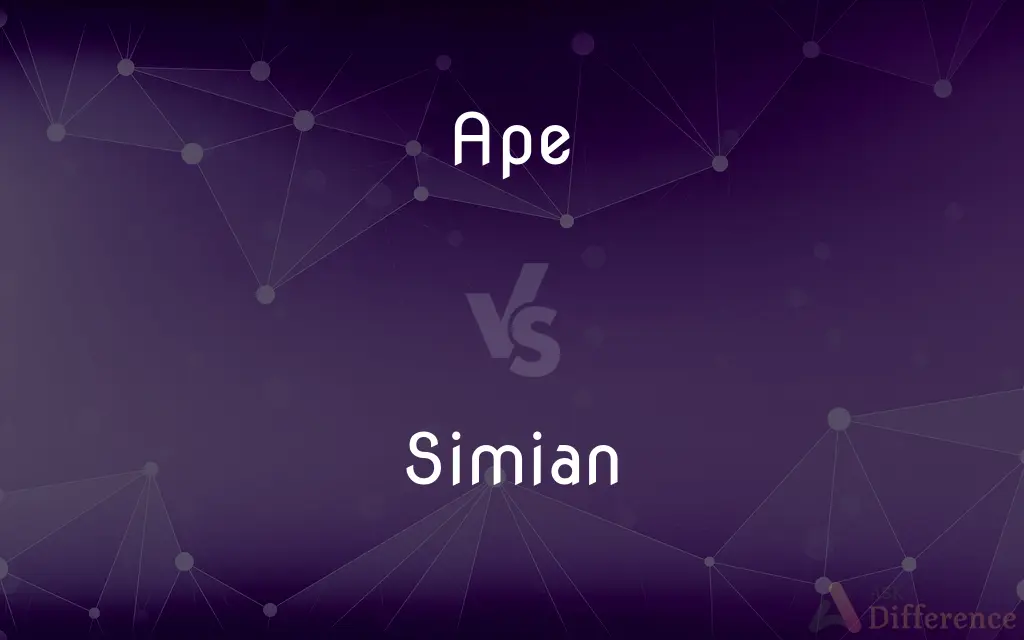Ape vs. Simian — What's the Difference?
By Urooj Arif & Fiza Rafique — Updated on April 5, 2024
Apes are tailless primates with more complex brains and behaviors, while simians include both apes and monkeys, characterized by their more developed cognitive abilities compared to other mammals.

Difference Between Ape and Simian
Table of Contents
ADVERTISEMENT
Key Differences
Apes, including gorillas, chimpanzees, and humans, are distinguished by their lack of tails and more complex brain structures, facilitating advanced problem-solving and social interactions. On the other hand, simians comprise a broader category that includes both apes and monkeys, united by their higher degree of cognitive abilities compared to other mammals but varying significantly in physical and behavioral traits.
While apes are known for their ability to use tools, communicate through complex gestures, and exhibit rich emotional lives, simians as a group also include monkeys, which may possess these abilities to a lesser extent but display a wider range of adaptations, from arboreal lifestyles to complex social hierarchies.
In terms of physical characteristics, apes are generally larger, have longer lifespans, and show more variation in facial expressions due to their complex musculature. In contrast, simians cover a spectrum that ranges from the smaller New World monkeys with prehensile tails to the larger, tailless apes.
Habitat-wise, apes are found primarily in Africa and Asia, living in various environments from rainforests to mountainous regions. Simians, however, have a broader distribution that includes both Old World and New World species, adapting to a wide range of habitats from dense forests to savannahs.
Despite their differences, both apes and the broader group of simians play crucial roles in their ecosystems, acting as seed dispersers, predators, and prey, highlighting their importance in maintaining ecological balance.
ADVERTISEMENT
Comparison Chart
Definition
Tailless primates with complex brains
Includes both apes and monkeys
Cognitive Abilities
Advanced problem-solving, tool use
Varied; generally high among mammals
Physical Traits
Larger body size, more facial expressions
Ranges from small monkeys to large apes
Habitat
Primarily Africa and Asia
Widespread, including Africa, Asia, and the Americas
Examples
Gorillas, chimpanzees, humans
All apes and monkeys, such as capuchins and baboons
Compare with Definitions
Ape
Tailless and highly intelligent primates.
Apes such as chimpanzees use sticks to fish for termites.
Simian
Includes both apes and monkeys, with varied traits.
Simians range from the small spider monkey to the large chimpanzee.
Ape
Use tools and exhibit problem-solving abilities.
Orangutans have been observed using leaves as umbrellas.
Simian
Found across Africa, Asia, and the Americas.
Howler monkeys, native to South American forests, are part of the simian group.
Ape
Capable of complex social interactions.
Gorillas live in groups with intricate social structures.
Simian
Some species have prehensile tails, unlike apes.
Spider monkeys use their prehensile tails as a fifth limb.
Ape
Generally larger and live longer than monkeys.
The average lifespan of a gorilla can exceed 40 years.
Simian
Play vital ecological roles in various environments.
Many simians are key seed dispersers in their habitats.
Ape
Found in Africa and Asia, in diverse habitats.
The Sumatran orangutan lives in the rainforests of Indonesia.
Simian
Diverse in size, habitat, and social structures.
Capuchin monkeys are known for their problem-solving skills.
Ape
Apes (Hominoidea ) are a branch of Old World tailless simians native to Africa and Southeast Asia. They are the sister group of the Old World monkeys, together forming the catarrhine clade.
Simian
The simians, anthropoids or higher primates are an infraorder (Simiiformes ) of primates containing the parvorders Platyrrhini and Catarrhini, the latter of which consists of the superfamilies Cercopithecoidea and Hominoidea (including the genus Homo). The simians are sister to the tarsiers, together forming the haplorhines.
Ape
A large primate that lacks a tail, including the gorilla, chimpanzees, orangutan, and gibbons.
Simian
Relating to, characteristic of, or resembling a monkey or an ape
Humans and other simian primates.
Ape
An unintelligent or clumsy person.
Simian
Relating to, characteristic of, or resembling a monkey or a nonhuman ape
Caricatures of politicians with simian features.
Ape
An inferior imitator or mimic
Cunning is but the ape of wisdom
Simian
A monkey or an ape.
Ape
Imitate (someone or something), especially in an absurd or unthinking way
New architecture can respect the old without aping its style
Simian
A monkey or a nonhuman ape.
Ape
Any of various tailless Old World primates of the superfamily Hominoidea, including the gibbons, orangutans, gorillas, chimpanzees, and humans.
Simian
Of or pertaining to apes; apelike.
Ape
Any of various members of this superfamily bearing fur and usually living in the wild, especially orangutans, gorillas, and chimpanzees, in contrast to humans. Not in scientific use.
Simian
Bearing resemblance to an ape.
Ape
A tailed primate such as a monkey. Not in scientific use.
Simian
An ape or monkey, especially an anthropoid.
Ape
A mimic or imitator.
Simian
Of or pertaining to the family Simiadæ, which, in its widest sense, includes all the Old World apes and monkeys; also, apelike.
Ape
(Informal) A clumsy or boorish person.
Simian
An ape or monkey
Ape
To imitate or mimic, especially in a thoughtless or inept way.
Simian
Relating to or resembling an ape;
Simian features
Ape
A primate of the clade Hominoidea, generally larger than monkeys and distinguished from them by having no tail.
Ape
Any such primate other than a human.
Ape
(derogatory) An uncivilized person.
Ape
One who apes; a foolish imitator.
Ape
(intransitive) To behave like an ape.
Ape
(transitive) To imitate or mimic, particularly to imitate poorly.
Ape
(slang) Wild; crazy.
We were ape over the new look.
He went ape when he heard the bad news.
Ape
A quadrumanous mammal, esp. of the family Simiadæ, having teeth of the same number and form as in man, and possessing neither a tail nor cheek pouches. The name is applied esp. to species of the genus Hylobates, and is sometimes used as a general term for all Quadrumana. The higher forms, the gorilla, chimpanzee, and ourang, are often called anthropoid apes or man apes.
Ape
One who imitates servilely (in allusion to the manners of the ape); a mimic.
Ape
A dupe.
Ape
To mimic, as an ape imitates human actions; to imitate or follow servilely or irrationally.
The people of England will not ape the fashions they have never tried.
Ape
Any of various primates with short tails or no tail at all
Ape
Someone who copies the words or behavior of another
Ape
Person who resembles a non-human primate
Ape
Imitate uncritically and in every aspect;
Her little brother apes her behavior
Ape
Represent in or produce a caricature of;
The drawing caricatured the President
Common Curiosities
Are humans considered simians?
Yes, humans are considered part of the simian group, which includes both apes and monkeys.
What are the habitats of apes?
Apes primarily inhabit the tropical forests of Africa and Asia, though they vary from rainforests to mountainous areas.
Can all simians use tools?
While tool use is most advanced in apes, some monkey species also exhibit basic tool-using abilities.
How do simians communicate?
Simians communicate through a variety of vocalizations, facial expressions, and body gestures, with apes showing more complex communication methods.
What role do apes play in ecosystems?
Apes are key to their ecosystems, acting as seed dispersers and helping to maintain forest diversity.
What is the largest ape?
The largest ape is the eastern lowland gorilla, with males weighing up to 440 pounds (200 kilograms).
What distinguishes an ape from a monkey?
Apes are larger, tailless, and have more complex brains than monkeys, which can have tails and are generally smaller.
Are all simians endangered?
Many simian species are endangered due to habitat loss, poaching, and other human activities, but the conservation status varies widely among species.
Do simians live in social groups?
Most simians, including both apes and monkeys, live in social groups that vary in size and structure.
How do apes contribute to biodiversity?
By dispersing seeds and maintaining forest structures, apes contribute significantly to biodiversity.
What are the conservation efforts for simians?
Conservation efforts include habitat preservation, anti-poaching measures, and rehabilitation centers for injured or orphaned individuals.
What is the difference in diet between apes and monkeys?
Apes tend to have a more varied diet including fruits, leaves, and occasionally meat, while monkeys typically have a broader diet that can include more seeds and insects.
What are the cognitive abilities of simians?
Simians, especially apes, are known for their cognitive abilities including memory, problem-solving, and the use of tools.
Can apes swim?
Most apes are not natural swimmers and have a fear of water, in contrast to some monkeys that can swim.
How do the physical abilities of apes compare to those of monkeys?
Apes generally have stronger physical abilities for climbing and manipulating objects due to their larger size and more complex musculature, compared to the more agile and versatile monkeys.
Share Your Discovery

Previous Comparison
Ingenuity vs. Originality
Next Comparison
Bibliophile vs. BibliophobiaAuthor Spotlight
Written by
Urooj ArifUrooj is a skilled content writer at Ask Difference, known for her exceptional ability to simplify complex topics into engaging and informative content. With a passion for research and a flair for clear, concise writing, she consistently delivers articles that resonate with our diverse audience.
Co-written by
Fiza RafiqueFiza Rafique is a skilled content writer at AskDifference.com, where she meticulously refines and enhances written pieces. Drawing from her vast editorial expertise, Fiza ensures clarity, accuracy, and precision in every article. Passionate about language, she continually seeks to elevate the quality of content for readers worldwide.














































